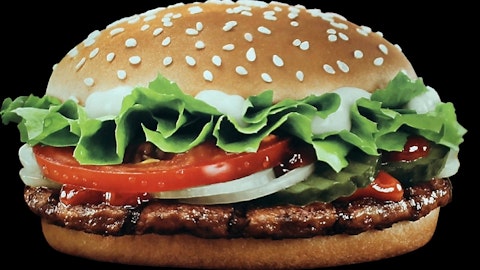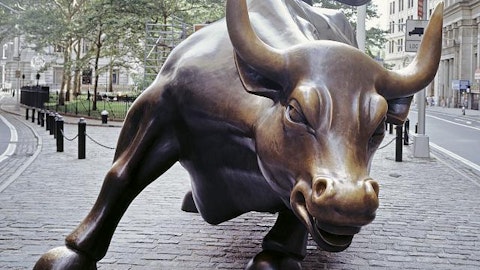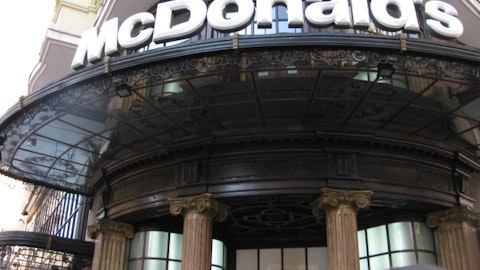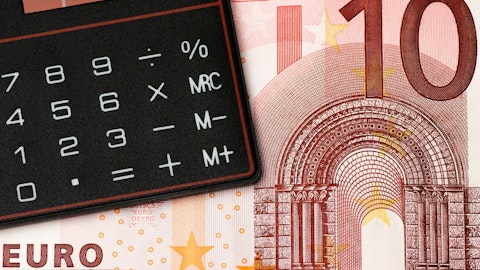McDonald’s Corporation (NYSE:MCD) Systems (the precursor to McDonald’s Corporation) was founded in 1955 when Ray Kroc went into business with brothers Dick and Mac McDonald who ran a small but successful hamburger restaurant.
Today, McDonald’s is anything but small. The company is the largest restaurant in the world, with a market cap greater than $100 billion and over 36,000 locations in more than 100 countries around the world.
It’s also the most popular restaurant stock among the elite investors that we track at Insider Monkey, 81 of which were long McDonald’s on June 3, holding $6.28 billion worth of its shares at that time, which totaled 6.90% of the iconic quick service restaurant’s common stock. While sentiment for the stock did fall during the second quarter, as ownership fell from 89 during the second quarter, there were several notable investors adding more shares of McDonald’s to their portfolios. Among them were billionaire Daniel S. Och of OZ Management, who upped his holding by 90% to 6.97 million shares, and Zach Schreiber of Point State Capital, who opened a new position containing 4.55 million shares.

You wouldn’t think an established hamburger business would be capable of rapid growth. From 2002 through 2011 McDonald’s did just that – realizing a compound earnings-per-share growth rate of 16.6% a year.
McDonald’s struggled in the late 1990’s and early 2000’s under CEO Jack Greenberg. Greenberg initiated a ‘made for you’ campaign that increasedcooking times, resulting in negative growth for McDonald’s. Jack Greenberg was replaced at the beginning of 2003 by Jim Cantalupo,
Cantalupo was only CEO of McDonald’s from 2003 to April of 2004, when he died suddenly and tragically of a heart attack. Despite his short tenure, Cantalupo is credited with turning around McDonald’s. He didn’t do anything revolutionary. He focused on cleanliness, quality, and consistency. He slowed store expansion (which was cannibalizing sales), eliminated unprofitable stores, and stopped engaging in absurd price wars with Burger King.
Jim Skinner took over as CEO when Cantalupo passed. Skinner’s focus was similar to Cantalupo’s. Skinners (successful) plan was to:
“(Put) the focus on the customer and the restaurants, and the absolutely relentless focus on improving existing restaurants”.
This is really not a revolutionary strategy. When you are the industry leader with the strongest brand, you don’t have to be revolutionary; you just have to allocate capital efficiently and stick with the company’s underlying competitive advantages. Under Skinner, earnings-per-share rose from $1.93 in 2004 to $5.36 in 2012.
Skinner retired in 2012, and was replaced by Donald Thompson. Earnings-per-share declined to $4.82 by fiscal 2014 as McDonald’s customer service slowed. The company registered the longest wait times it had in 15 years in 2014.
Steve Easterbrook replaced Thompson in March of 2015. Since then, he has announced the company will switch to cage-free eggs in 10 years (that’s quite a long time for a switch…). The company is also raising pay in company owned stores to at least $1 above minimum wage. In addition, McDonald’s is slowly slimming down its menu, cutting 7 sandwiches so far.
While change has been incremental so far, Easterbrook and McDonald’s are beginning to see positive results. The company saw comparable store sales growth of 4% in its most recent quarter globally. Comparable store sales in the United States rose 0.9% – the first increase in 2 years.
Whether Easterbrook will follow in the footsteps of former CEOs Cantalupo and Skinner, or Thompson and Greenberg remains to be seen. Early results are promising, however.
Competitive Advantage
McDonald’s competitive advantage comes primarily from three factors:
- Well-known brand
- Industry leading size and scale
- Capital efficient franchise business model
The company’s “I’m Lovin’ It” slogan (recorded in the United States by Justin Timberlake) is well known throughout the world. An instrumental version of the song by Pharrell Williams actually topped the charts in Belgium.
McDonald’s supports its brand with significant advertising expenditures. The company’s ad spend for each of the last 3 full fiscal years is shown below:
- $907 million in 2014
- $884 million in 2013
- $901 million in 2012
In total, McDonald’s spends about 5% of its revenue on advertising. The company currently has a market cap over $100 billion. The 2nd largest restaurant in the world – Yum! Brands, Inc. (NYSE:YUM) – has a market cap of $31 billion. McDonald’s tremendous size and focus allows it to outspend its rivals in advertising.
McDonald’s Corporation (NYSE:MCD) has more than 35,000 locations in over 100 countries. In Europe, North America, and increasingly Asia, McDonald’s is very easy to find. The company’s ‘Golden Arches’ are recognized throughout the world.
The company’s massive size relative to its peers allows it to buy commodity food products from suppliers at the lowest possible price. McDonald’s has historically offered extremely affordable “value menu” and “dollar menu” offerings.
McDonald’s has managed to grow to over 36,000 locations by pioneering the franchise business model. Only about 20% of McDonald’s locations are company operated. The remaining 80% are operated by entrepreneurs who pay to use the McDonald name and products. Franchising minimizes the cost of opening a store for McDonald’s and spreads risk to the franchise owner rather than McDonald’s corporation. It results in a highly capital efficient business that is easy to scale.
Growth Prospects
McDonald’s has the potential to realize solid growth for shareholders. The company is committed to becoming more capital efficient by increasing its franchised store count from 81% to 90%.
The company is also slowly focusing on healthier/more natural ingredients and a more streamlined menu in efforts to better serve customers.
If things go well for McDonald’s, the company’s expected total returns will come from the following sources:
- 3.0% from dividends
- 3.0% from store count growth
- 3.0% from comparable store sales increases
- 1.5% from share repurchases
- 1.0% from margin improvements
This would result in total returns of around 11.5% a year. This is the bull case for McDonald’s – if the company continues solid results from its most recent quarter.
If comparable store sales stagnate (or even decline) as they did in 2013 and 2014, McDonald’s shareholders should expect total returns of 7% to 8.5% a year from the same sources above (and accounting for flat or negative comparable store sales growth).
When one examines the bull and bear case for the company, one realizes how consistent McDonald’s is. The company can continue to build out stores, pay dividends, and repurchase shares to generate solid returns for shareholders. In addition, margins should rise as the company switches more stores to being franchises.
Recession Performance
From 2007 through 2009, McDonald’s stock generated total returns of 55.9% for shareholders, while the S&P 500 had total returns of negative 15.9%.
McDonald’s is the most recession-resistant Dividend Aristocrat. The company’s performance over the Great Recession of 2007 to 2009 is nothing short of remarkable. The company’s earnings-per-share growth through the Great Recession is shown below to illustrate this point:
- 2007 earnings-per-share of $2.91
- 2008 earnings-per-share of $3.67
- 2009 earnings-per-share of $3.98
McDonald’s performs well through recessions because it is known to sell cheap food. Consumers become more cost-conscious during recessions and substitute higher priced dining experiences for lower priced options like McDonald’s.
Final Thoughts
McDonald’s Corporation (NYSE:MCD) is a high quality business with a strong and durable competitive advantage. The company tends to tread water when management doesn’t focus on the company’s value proposition of cheap food fast – from a clean store. When management is on point, however, McDonald’s share holders tend to see solid gains.
The company is currently trading for an adjusted price-to-earnings ratio of 23.3. This is well above the company’s historical average price-to-earnings ratio over the last decade of 16.6.
At current prices, McDonald’s is likely trading above fair value. Potential investors looking to initiate a position in McDonald’s should wait till the company’s stock price falls somewhat before buying new shares.
As a high quality company with an above average dividend yield of 3% and solid expected total return potential, McDonald’s is a hold for long-term investors using The 8 Rules of Dividend Investing.
Disclosure: None





